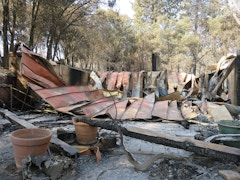
117 results
-
 Facades developed in response to climactic factors increase performance and human comfort while reducing energy loads. A single building envelope…
Facades developed in response to climactic factors increase performance and human comfort while reducing energy loads. A single building envelope… -

Addressing climate change through façade design - Vaclav Hasik
- Article by Vaclav Hasik
There is a growing awareness and interest in understanding the carbon footprint of material manufacturing, opening doors to new opportunities in facade design and manufacturing innovation. There are steps and decisions we can make today to help fight climate change.
-

Impact of Climate Change: Thermal and Energy Performance of Facade Types in Different Climates copy
As global temperatures continue to rise, researchers are examining the building envelope’s impact on climate-specific guidelines to create a more sustainable built environment.
-
Cities under Climate Threat - Philadelphia, Rome and Venice
- Paper by Edgar Stach, Dr., Ing, AIA/IA, Professor Shreya Kanther, Ph.D Candidate Alexis Manfre, Student
The impacts of climate change, driven by increasing extreme temperature, sea-level rise, and heavy precipitations, interact and play an essential… -
Emissions Limits Critical to Climate Initiatives
- Article by Valerie Block
There have been 26 Conferences on Climate Change sponsored by the United Nations. The most recent conference, COP 26, was held in 2021 in Glasgow, Scotland. With 200 countries in attendance, all eyes were set on achieving the goal of limiting the rise in global temperature to 1.5 degrees Celsius.
-

U-Factor Matters in Hot Climates
- Paper by Helen Sanders, PhD
It is commonly thought that fenestration U-factor is not a key determinant in the performance of facades in hot climates, and generally the focus of
-

Drawdown: Paul Hawken Gets Real with Climate Change
- Article by Mic Patterson, PhD, LEED AP BD+C, Ambassador of Innovation and Collaboration
Drawdown is an inspiring new effort to manage atmospheric carbon and the resulting climate impacts. This brief reveiw discusses the book, the movement, and the potential.
-

European Facade Networks
- Paper by Ulrich Knaack · Uta Pottgiesser · Tillmann Klein · Andreas Luible · Siebe Bakker
The European climate and energy targets for 2020 demand significant improvement of the energy performance of buildings since one third of the
-

Green Façade/Roofs Design Tool
- Paper by Abolfazl Ganji Kheybari, Researcher and Building Physics Expert Morteza Kasravi, Computer Scientist
Climate change and related thermal issues, draw attention to the impact of green facades and roofs on energy savings and thermal comfort. Besides, by… -
Contextualizing Glass and Carbon Impacts
- Paper by Kayla Natividad, PhD, WELL AP, LEED Green Associate · Kyle Sword
Climate change goals will require significant improvements in the way buildings are constructed and operated. Building reuse can combat climate
-
Wind-Borne Debris Impacts on Façades
- Paper by Angela Mejorin, Ph.D., Researcher
Climate change effects are causing an increase in extreme wind events’ frequency and severity, worldwide. Regions that previously were not prone to
-

AIA Conference on Architecture 2021
- Event by AIA
A’21 brings together leaders in architecture and beyond for a four-day, immersive digital experience that defines the year ahead. It’s the architecture and design event of the year!
-
Rammed Earth & Wildfire
- Paper by Brittany Dhawan, AIA
California is set to be drier and more drought prone with climate change. Wildfire and the subsequent loss of life and housing is a huge challenge.
-

Q&A with StudioTJOA, Creator of the Award Winning Thermalswitch Facade
- Article by Matt Elder
Inspired by the President’s Climate Action Plan and Architecture 2030 Challenge, Metals in Construction magazine and the OMINY tapped designers in late 2015 to create an eco‐friendly, highly transparent enclosure that preserves the aesthetic integrity of 200 Park Ave.
-
Dynamic Shading Device
- Paper by Gabriel de Bem · Eduardo Krüger · Alexandre Augusto Alberto Moreira de Abreu
Responsive shading systems can dynamically improve indoor environmental conditions based on outdoor climate variations. Among the technologies,
-

Living Future '20
- Event by International Living Future Institute
A compelling, hopeful vision for the future is what the International Living Future Institute was founded on, and what drives our team. Join us and share what sustains your hope for our future.
-

Stop F*cking Around – Build Our Zero Carbon Economy Now
- Article by Drew Shula
To avoid the worst effects of the climate crisis, we urgently need to reduce carbon emissions now. But that's not enough! This original article for SKINS by Drew Shula is a veritable manifesto on the why and how of climate action for all of us.
-

Terra Cotta Skins
- Paper by Laura B. Garofalo, Assistant Professor
This paper will address the potential of ornamental architectural terracotta surfaces to mitigate the effects of climate fluctuations that will… -
3D thermal modelling of complex facades
- Paper by Wout Parys · Piet Houthuys
Today’s building enclosures face ever greater demands regarding their thermal performance. In cold climates, the required total U-value of the façade
-

Build Test Iterate Repeat
- Paper by Elizabeth L McCormick, RA, CPHC, LEED AP, Assistant Professor
The global increase in atmospheric temperature rise combined with the rapid growth of previously underdeveloped climate zones presents a growing need…
